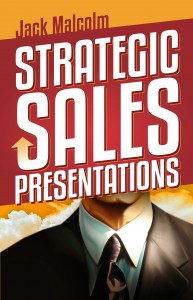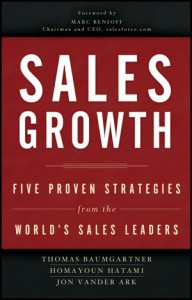 As should be obvious to my readers by now, I’ve recently been on a kick to apply lean principles to sales and personal productivity. The core of lean is to reduce muda, or waste, and waste is defined as any activity that does not add value to the customer.
As should be obvious to my readers by now, I’ve recently been on a kick to apply lean principles to sales and personal productivity. The core of lean is to reduce muda, or waste, and waste is defined as any activity that does not add value to the customer.
If you work in sales for a company, you probably have to enter an account plan into a CRM system, and you are very likely less than enthusiastic about it. Companies love CRM systems because it helps them capture information about their customers, but one of the major challenges is to get salespeople to consistently supply accurate information.
Why is that? There are actually three customers for the activities that salespeople perform: their customers, their employers, and themselves. In many cases, the only one of those three who receives value from many CRM systems is the employer.
Salespeople naturally would rather spend their time in front of customers than in front of computer screens filling out forms, so they’re naturally reluctant to take the time. In addition, they often see the systems as a surveillance tool that their management uses to keep tabs on their activities.
Customers don’t care if the account plan gets into the seller’s CRM, because to them that is not an activity that adds value. In fact, if they can’t reach the account manager because he or she is busy filling out their forms, they see it as worse than waste.
Fortunately there is a way out of this. The trick is to design the plan so that it adds value to all three stakeholders. A properly designed account plan does more than capture static information about a customer. It allows for the salesperson to think critically and plan for ways to deliver insights, consulting, or solutions[1] to help their customers improve their business.
Salespeople will get value from the plan if it helps them focus their thinking on what they know and don’t know about their customers’ needs and decision process. Probably the major benefit that participants in my account planning workshops get is uncovering the “unknown unknowns”, those hidden land mines that often turn out to be the difference-makers in winning or losing business. Most salespeople are way overconfident about how much information they carry in their heads. They think that they know everything they need to know about the customer’s situation, and the only way to expose the fallacy is to force them to write down the answers to hard questions. When they uncover what they know and don’t know about the customer’s needs, the solution fit and the decision process, their action steps become much clearer to them, which leads to less wasted activity and shorter selling cycles. Well-designed account plans also share information within the various members of the sales team and help spark additional ideas.
How does the customer benefit from well-designed account plans? When salespeople are sincerely using plans to figure out better ways to provide value, solve problems, or help the customer achieve their business and personal goals, they will bring better solutions. They will also waste less of the customers’ time.
In fact, if the employer designs the account plans from the point of view of helping salespeople better add value to the end customer, their own value will take care of itself, because salespeople will embrace the process and consistently provide accurate and valuable information.
Actually, you could apply this approach to any sales activity. Simply ask yourself how much value each customer of the activity is getting from it. Those that help the end customer and the salesperson, usually end up benefiting the employer as well.
[1] I’m covering my bases with the Challenger Selling and Solution Selling camps here. Just call me Switzerland.
 Tens of thousands of sales presentations are delivered to potential customers every day, but very few of them are strategic sales presentations.
Tens of thousands of sales presentations are delivered to potential customers every day, but very few of them are strategic sales presentations.
A sales presentation is strategic when it delivers the right content to the right people at the right time to advance or close your sale.
Right content: The majority of sales presentations are really talking brochures, in which the salesperson verbally delivers content that is easily available to audience members on web pages or in promotional material. It usually talks about the features of the product or touts the virtues of the company selling it. Right content is about the customer: how their business outcomes can be improved through their decision to buy your offering. How will their current processes be improved, what problems will be solved, and what will be the financial impact of these changes? One simple test is to look at your content and calculate the percentage that talks about your customer versus about yourself and your solution. In addition, calculate how much of the content is specific to that one customer at that particular time. You can take this even further by ensuring that content is targeted to the needs and concerns of specific individuals.
Right people: Very early in the sales cycle, you may need an executive to be present to ensure the project receives the priority it deserves, and of course you want them there for the closing presentation. But be careful of imposing on their time when you’re not directly adding value to them. In the evaluation stage of the customer’s buying process, their presence may be unnecessary and even counterproductive.
It’s also a natural tendency to want to pack the audience with your supporters and avoid detractors or opponents. If you have identified opponents in the decision process, it is crucial to have them there when you present, even if it adds another level of stress. This will at least give you a chance to answer their objections. If you exclude them, they will just voice their objections when you’re not there. Or, if they feel the decision was forced on them, you’re going to have a tough time during implementation even if you do make the sale.
Right time: You have to understand where your customer is in their buying cycle and tailor your content accordingly. If they haven’t fully recognized their need, for example, it would be premature to focus on the superiority of your solution.
There’s a saying that nothing is as powerful as an idea whose time has come, which implies that the idea will fall flat if the time is not right. If what you are selling is a radical departure from status quo or challenges long-held beliefs and attitudes, it’s unlikely that you will succeed in one shot. In such cases, the quiet behind-the-scenes selling and lobbying you do will shape the conditions for success.
Advance the sale: A sales presentation is still a sales call, and one of the most fundamental—and ignored—steps in sales calls is to specify up front your purpose for the call. The call purpose must be viewed within the context of the sales opportunity plan, and thus must include a measurable advance in the sales cycle. It does not have to be a close; in long complex sales cycles closing calls are in the minority. But it should add value to the seller and the buyer. (In fact, you could profit from changing the wording to “advance the buying decision in your favor”.)
For example, a purpose could be to “gain agreement on the cost of the problem”. This purpose adds value to the seller by increasing the buyer’s urgency to make a decision and potentially shortening the sales cycle. The buyer benefits by recognizing the scope of the problem and possibly by gaining insights that will help them improve the potential solution.
To ensure that your sales presentation is strategic, then, use this short checklist:
Do I have the right content that targets your listeners’ unique needs and concerns?
Are the right people in the room?
Is this the right time for this presentation?
Am I crystal clear on what I want to achieve and why?
 This week’s book recommendation is Sales Growth: Five Proven Strategies from the World’s Sales Leaders
This week’s book recommendation is Sales Growth: Five Proven Strategies from the World’s Sales Leaders, by McKinsey and Company partners Thomas Baumgartner, Homayoun Hatami and Jon Vander Ark.
With a few exceptions, you may not find a lot of jaw-dropping revelations in the book, but it’s well worth reading for the three important services it provides for sales leaders and for the profession of sales:
First, it provides a template of best practices being used by some top sales organizations. They interviewed 120 sales executives from 100 large companies in 10 industry sectors that have “significantly outperformed their peers”. Although this is far short of gold standard for research methods, it’s far better than many similar sales books (and business books in general) that claim to have found the secrets to success, so their prescriptions are worth reading. The five strategies are:
- Find growth before your competitors do
- Sell the way your customers want
- Soup up your sales engine
- Focus on your people
- Lead sales growth
Each strategy is further broken down into specific practices, and support for their success is provided statistically and anecdotally. They are summarized in a table at the end of the book which compares “good” to “great” practices; in my opinion, the eight pages from 207-214 are more than worth the price of the book and should be taped up in the offices of every sales executive. While few of the strategies will be a revelation to any sales professional, I’d venture to guess that no one is firing on all cylinders on more than one or two.
Second, the book reinforces a growing and welcome trend toward moving sales from an art to a science, by putting data at the heart of it. If we want sales to be more professional and a more respected aspect of business, we’ve got to become more data-driven. In fact, one of the relatively new topics covered in the book is the use of Big Data to support several of the five strategies, and we’re going to see much more about this in the near future. There are several good examples of companies using it to look beyond averages to identify opportunities at a much more granular level, to gain insights from social media, an—most importantly—to provide actionable insights to individual salespeople. As the data crunchers get better at doing the latter, you’re going to see much more demand for it from the field.
Finally, if you’ve ever had the frustrating experience of vainly trying to get your message across to top management, only to have them jump on it when a prestigious consultant says it, you will appreciate the third service provided by Sales Growth. It’s hard to have a more prestigious mouthpiece than McKinsey in your corner. So, if you’re a sales leader and have been trying to get more resources or attention for some of your sales initiatives, make sure a copy of this book finds its way to your executive suite.
There is an article in the most recent issue of Harvard Business Review titled “The End of Solution Sales” by Brent Adamson, Matthew Dixon and Nicholas Toman. Their premise is that customers today are so well informed that they already know how to solve their own problems, so they don’t need sales reps to sell them solutions. Instead, the top performers sell “insights” to customers who have emerging needs or whose organizations are in a state of flux. They then go further, coaching their customers on how to buy.
Dave Brock took exception to their premise in his latest blog post. He offered an eloquent defense of the concept of solution selling, saying that the article is “wordsmithing and positioning”, and that insight selling is just a form of solution selling. As he said, “…if it looks like Solution Selling, smells like Solution Selling, sounds like Solution Selling, then it must be Solution Selling.” So, he lumps the two concepts together and then also throws Consultative Selling into the same pile for good measure.
My own perspective on the debate is that selling insights is different than solution selling, but that solution selling is still far from dead.
Definitions do matter…
I believe it’s useful to distinguish between the approaches,



